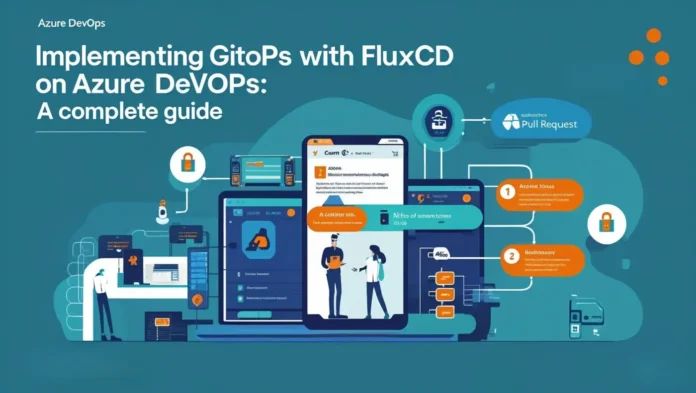Introduction
GitOps is a modern approach to continuous delivery that uses Git as the single source of truth for infrastructure and application deployments. FluxCD is a leading GitOps operator for Kubernetes, automating deployments by syncing your cluster with a Git repository.
This guide provides a step-by-step, professional walkthrough for integrating FluxCD with Azure DevOps, covering:
- GitOps Principles & FluxCD Architecture
- Setting Up FluxCD on AKS (Azure Kubernetes Service)
- Configuring Azure DevOps for GitOps Workflows
- Advanced FluxCD Features (Kustomize, Helm, Notifications)
By the end, you’ll have a fully automated GitOps pipeline that syncs AKS with your Azure Repos/GitHub repository.
1. Understanding GitOps & FluxCD
1.1 What is GitOps?
✅ Declarative Infrastructure (Define everything in Git: manifests, Helm charts)
✅ Automated Synchronization (FluxCD continuously reconciles cluster state with Git)
✅ Audit & Rollback (Git history tracks all changes)
1.2 How FluxCD Works
- Watches a Git repo for changes (YAML/Helm/Kustomize).
- Detects drift between Git and cluster, auto-reconciles.
- Supports multi-tenancy (Multiple teams, namespaces).
2. Setting Up FluxCD on AKS
2.1 Prerequisites
- AKS Cluster (Running Kubernetes
1.20+) - kubectl & Helm installed
- Azure DevOps/GitHub Repo (For manifests)
2.2 Installing FluxCD via Helm
- Add the FluxCD Helm repo:
helm repo add fluxcd https://fluxcd-community.github.io/helm-charts- Install FluxCD:
helm upgrade --install flux fluxcd/flux2 \
--namespace flux-system \
--create-namespace \
--set watchAllNamespaces=true- Verify installation:
kubectl get pods -n flux-system3. Connecting FluxCD to Azure DevOps/GitHub
3.1 Configuring Git Repository Sync
- Create a Git Repo (e.g.,
azure-devops/flux-config) with:
├── clusters/
│ └── prod-aks/
│ ├── flux-system/
│ │ └── gotk-components.yaml
│ └── apps/
│ ├── namespace.yaml
│ └── kustomization.yaml- Apply FluxCD manifests:
kubectl apply -f clusters/prod-aks/flux-system/gotk-components.yaml3.2 Setting Up Git Authentication
Option 1: SSH Key (Recommended)
- Generate an SSH key:
flux create secret git flux-ssh-auth \
--url=ssh://git@ssh.dev.azure.com/v3/yourorg/yourrepo \
--namespace=flux-system- Apply the
GitRepositorymanifest:
apiVersion: source.toolkit.fluxcd.io/v1beta2
kind: GitRepository
metadata:
name: flux-config
namespace: flux-system
spec:
interval: 1m
url: ssh://git@ssh.dev.azure.com/v3/yourorg/yourrepo
secretRef:
name: flux-ssh-authOption 2: Azure DevOps PAT (Personal Access Token)
flux create secret git flux-pat-auth \
--url=https://dev.azure.com/yourorg/yourrepo \
--username=git \
--password=<PAT_TOKEN>4. Configuring Azure DevOps CI/CD for GitOps
4.1 CI Pipeline (Build & Push Manifests)
- Trigger on Git changes (YAML example):
trigger:
branches:
include: [ main ]
paths:
include: [ 'manifests/*' ]- Validate & Push Changes:
jobs:
- job: ValidateManifests
steps:
- script: kubectl apply --dry-run=server -f manifests/
- job: CommitAndPush
steps:
- script: |
git config --global user.email "fluxcd@azuredevops.com"
git add .
git commit -m "Update manifests"
git push origin main4.2 CD via FluxCD (Auto-Sync)
- FluxCD watches the repo and applies changes automatically.
- Rollback: Revert a Git commit → FluxCD rolls back the cluster.
5. Advanced FluxCD Features
5.1 Kustomize & Helm Support
- Kustomize Overlays:
apiVersion: kustomize.toolkit.fluxcd.io/v1beta2
kind: Kustomization
metadata:
name: app-deployment
namespace: flux-system
spec:
interval: 5m
path: ./clusters/prod-aks/apps
sourceRef:
kind: GitRepository
name: flux-config- Helm Releases:
apiVersion: helm.toolkit.fluxcd.io/v2beta1
kind: HelmRelease
metadata:
name: nginx
namespace: default
spec:
chart:
spec:
chart: nginx
sourceRef:
kind: HelmRepository
name: bitnami
interval: 5m5.2 Notifications (Slack, Teams, Azure DevOps)
- Configure Alert Providers:
flux create alert-provider azuredevops \
--type=azuredevops \
--username=flux-bot \
--webhook=https://dev.azure.com/yourorg/_apis/distributedtask/hooks/webhook- Define Alerts:
apiVersion: notification.toolkit.fluxcd.io/v1beta1
kind: Alert
metadata:
name: deployment-alerts
namespace: flux-system
spec:
providerRef:
name: azuredevops
eventSeverity: info6. Best Practices for GitOps with FluxCD
✅ Use Separate Repos for Dev/Prod (Or branches with Kustomize overlays)
✅ Immutable Releases (Tag Helm charts, avoid latest)
✅ RBAC for FluxCD (Limit cluster access)
✅ Monitor Sync Status (flux get kustomizations --watch)
✅ Automated Testing (Pre-commit validation with conftest)
Conclusion
By combining FluxCD with Azure DevOps, you achieve:
🚀 True GitOps (Git as the single source of truth)
🔒 Security & Compliance (Audit trails via Git history)
⚡ Zero-Downtime Deployments (Automated sync + rollback)
Next Steps
- Explore FluxCD + Helm Secure Supply Chain (Cosign, OCI registries).
- Implement Multi-Cluster GitOps (Fleet Management).
- Set up Drift Detection Alerts.

